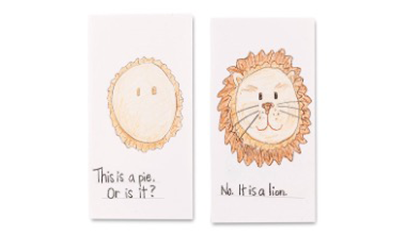Learning Area: Language Arts, Mathematics, Science, Ecology, Technology, and Visual Arts
Time: Two 30-minute periods
Grades: Kindergarten, Grade 1, Grade 2, Grade 3
Sponsored by:

Materials:
- Crayola Classic Crayons
- Crayola Washable Markers
- White paper or blank index cards
- Optional: Crayola Metallic Crayons
Instructions
RESPOND to the new classroom or other parts of the school such as the library, with an eye for objects’ shapes and details. Urge students to use descriptive vocabulary as they describe what they have seen, focusing on geometric shape and color names.
CREATE two picture cards that each use the same shape and color but have different details. Students start by drawing the same simple geometric shape on both cards with their crayons, based on what they observed in their environment. Then they imagine what that shape could become—modifying the shape into two different images that have different details. Label one card: “This is a _______. Label the other card, “Or is it a ________?”
They are now ready to play the game!
PRESENT the finished two cards as an observation guessing game by asking classmates to name the objects. If the classmates’ responses are different from what the artists had identified, they can keep the conversation going by asking, “Why did you say that?” “What else could it be?” These conversations develop skills of speaking and listening, as well as interpreting, expressing, and conveying ideas.
CONNECT the games students created with the big idea that every simple shape can be drawn and embellished to become whatever you want it to be. Every object in the school and classroom can be seen as a basic shape that has added details that inform the function.
Use this lesson as a springboard to discuss how we can reframe our thinking and see spaces and objects in different ways.
Learn More:
- Make connections between visual arts and other disciplines. Invite the class to investigate the art of Pablo Picasso, M.C. Escher, Paul Klee, and others who used part-to-whole perception and transformed images of objects, people, and places, into a series of interconnected geometric shapes.
- Play “I Spy” games where children choose and then describe an object citing its specific shape and color. Others look around and identify objects that have that shape and color. If classmates are struggling to identify the object the leading child has in mind, they can receive more clues, such as size, texture, and location until they realize what object the child leader had in mind. Whoever identifies the object first becomes the leader of the next round.
- Explain to students that when one thing is turned into another, it is called a metamorphosis. In the natural world, help them find examples such as animals and insects such as amphibians, butterflies, tadpoles, etc. Discuss how this activity can be seen as a metamorphosis from a basic shape to a more detailed object.
- Include the collection of student-created games in your classroom library so that students can borrow, use, and return those that were made by classmates and enjoy what they created throughout the year.







buying prescription drugs in mexico online buying prescription drugs in mexico or medication from mexico pharmacy
http://www.bssystems.org/url?q=https://mexicanpharm.online mexican mail order pharmacies
mexican drugstore online mexican pharmacy and mexico pharmacy medicine in mexico pharmacies